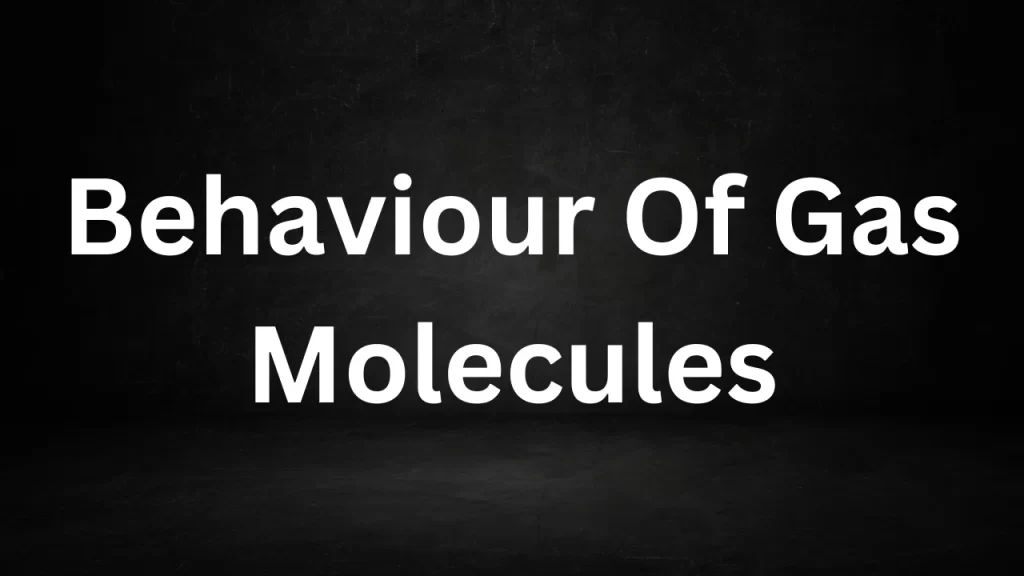Behaviour Of Gas Molecules: The behavior of gas molecules is a fascinating topic in the realm of physics and chemistry.
To comprehend how gases behave under various conditions, scientists have developed the Kinetic Theory of Gases, which provides valuable insights into the movement, interactions, and properties of gas molecules.

Behaviour Of Gas Molecules
Key Assumptions of the Kinetic Theory of Gases:
- Gas Molecules are in Constant Motion: According to the kinetic theory, gas molecules are in a continuous state of motion. They move randomly and rapidly in all directions, colliding with each other and the walls of their container.
- Negligible Volume and Particle Size: Gas molecules are considered to have negligible volume compared to the total volume of the gas and are treated as point particles. The distances between gas molecules are relatively large compared to their sizes.
- Elastic Collisions: Gas molecules undergo perfectly elastic collisions with each other and the walls of the container. In an elastic collision, both kinetic energy and momentum are conserved.
- No Interactions Except During Collisions: Gas molecules do not exert attractive or repulsive forces on each other except during collisions. This is in contrast to liquids and solids, where intermolecular forces play a significant role.
- Average Kinetic Energy is Proportional to Temperature: The kinetic energy of gas molecules is directly proportional to the absolute temperature (in Kelvin) of the gas. This relationship is described by the equation:Where:
- is the average kinetic energy of gas molecules.
- is the Boltzmann constant.
- is the absolute temperature in Kelvin.
Consequences of the Kinetic Theory:
- Pressure: The pressure exerted by a gas on the walls of its container is a result of the constant collisions of gas molecules with those walls. More frequent and forceful collisions result in higher pressure.
- Temperature and Kinetic Energy: As the temperature of a gas increases, the average kinetic energy of its molecules also increases. This leads to faster molecular motion and more energetic collisions.
- Volume and Molecular Density: Changes in volume affect the density of gas molecules. If the volume of a gas is decreased while keeping the number of molecules constant (as in compression), the density of gas molecules increases, leading to higher pressure.
- Diffusion and Effusion: Gas molecules move from areas of high concentration to low concentration through diffusion. Effusion is the process by which gas molecules escape through a small opening. Both processes are explained by the random motion of gas molecules.
- Gas Laws: The kinetic theory provides a theoretical foundation for various gas laws, including Boyle’s Law, Charles’s Law, and Avogadro’s Law, which describe the relationships between pressure, volume, temperature, and the number of gas molecules.
In conclusion, the behavior of gas molecules is governed by the principles of the Kinetic Theory of Gases. Understanding this theory allows scientists and engineers to make predictions about the properties and behavior of gases under different conditions, which is essential in fields ranging from chemistry and physics to engineering and atmospheric science.
Read More
- Molar Mass Of Oxalic Acid
- Types Of Chemical Bonding
- Chemistry In Everyday Life
- Energy Stored In A Capacitor
- Compound Lenses Thin Lenses In Contact
Frequently Asked Question (FAQs) Behaviour Of Gas Molecules
-
What is the Kinetic Theory of Gases?
The Kinetic Theory of Gases is a scientific model that describes the behavior of gas molecules. It is based on several key assumptions, including that gas molecules are in constant motion, have negligible volume and particle size, undergo elastic collisions, and have average kinetic energy proportional to temperature.
-
What is the significance of gas molecules being in constant motion?
The constant motion of gas molecules explains many macroscopic properties of gases, such as pressure, temperature, and volume. It helps us understand how gases fill containers, exert pressure on their surroundings, and diffuse or mix with other gases.
-
How do gas molecules exert pressure?
Gas molecules exert pressure by colliding with the walls of their container. The force of these collisions per unit area is what we perceive as gas pressure. An increase in the frequency or force of collisions leads to higher pressure.
-
Why do gas molecules have negligible volume and size in the Kinetic Theory?
Considering gas molecules as having negligible volume and size simplifies calculations and is a reasonable approximation because the distances between gas molecules are much larger than their sizes.
-
What is an elastic collision, and why is it important in the Kinetic Theory of Gases?
An elastic collision is a collision in which both kinetic energy and momentum are conserved. In the context of the Kinetic Theory, elastic collisions between gas molecules and container walls help explain how gases exert pressure and how energy is transferred within the gas.
